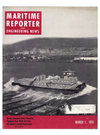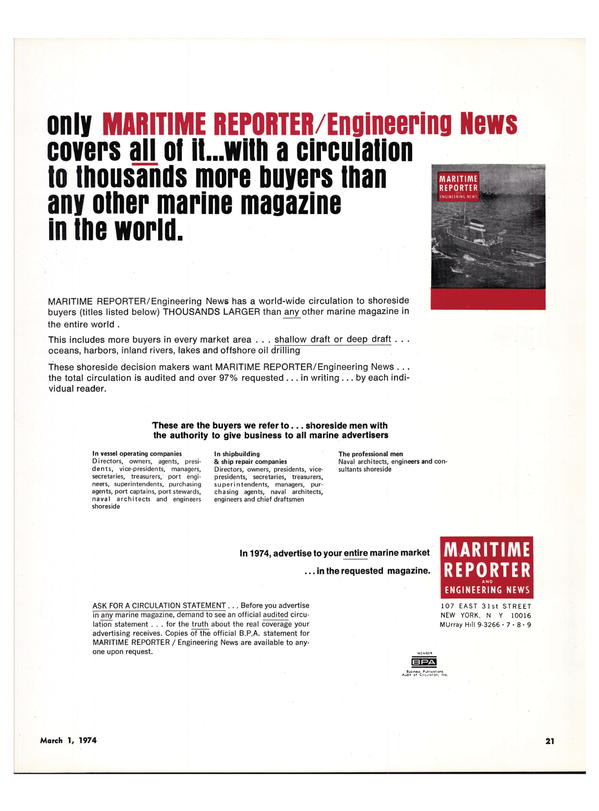
First Phase Of New Keppel Subsidiary, Tuas Shipyard, To Cost $70 Million —A Number Of Key Appointments Made
Over the last three years, the volume of ship repair work handled 'by Keppel Shipyard (Private) Ltd., Singapore, has more than doubled, and the point has now been reached when investment in new facilities is essential if the company is to continue to grow.
Over the last two years, several comprehensive economic and technical studies regarding investment in a new drydock have been made.
The present drydocking facilities are limited to 40,000 dwt and with the growth of ship size, even for a "middle-size" shipyard such as Keppel, this is now inadequate.
A new subsidiary, Tuas Shipyard, is to 'be started and in its first phase of development, a drydock of 150,- 000-dwt capacity will be Ibuilt. For future expansion, the site area will provide space for another two drydocks. Preliminary engineering studies have been completed and work on the first phase, costing some $70 million, will begin this year. The new shipyard is expected to 'become operational in 1976.
1974 sees some reshuffling in the key people in the company. C.N.
Watson, hitherto managing director on loan from the Swan Hunter Group, leaves Keppel to take over as managing director of the other Swan Hunter interest in Singapore, the ex-Naval Dockyard, Sembawang Shipyard. He will be succeeded by the present general manager, C.T. Chua. Mr. Chua started his career as an apprentice in the Naval Dockyard, and after joining the Singapore Harbour Board, he won a scholarship to Newcastle University, where he took his degree in naval architecture and was a Burrill Medallist. On his return to Keppel Shipyard in 1968, Mr. Chua held positions as ship repair manager, general manager of a Keppel subsidiary company, then for the last two years as general manager of the parent firm. Mr. Chua is also this year's president of the Singapore Association of Shipbuilders and Repairers.
W.S. Loh, works manager, will succeed Mr. Chua as general manager.
With Keppel since 1960, he was awarded a three-year scholarship to study electrical engineering at Faraday House Engineering College, London. He graduated in 1966 and was winner of the college's gold medal. He was appointed electrical engineer on his return to Keppel, and he has been works manager since 1971.
Taking over as works manager will 'be Y.F. Tham, who is presently marine manager. With this move, Mr. Tham will now have handled all three of the key operational1 departments, because from 1970 to 1972 Mr. Tham served as commercial manager, and from 1972 to 1973 as marine manager. This is in line with company policy to develop managers with a broad background and experience. Mr. Tham studied marine engineering at the Singapore Polytechnic while undergoing his apprenticeship with Keppel.
On completion of his apprenticeship, he spent two years with Blue Funnel, and Maersk Lines, rejoining Keppel in 1968. Then from foreman engineer, he rose through chief billing officer to deputy commercial manager and commercial manager.
Now promoted to marine manager, Y.H. Kung, presently assistant marine manager, is a man of vast and varied experience in marine engineering. He is a former dockyard department apprentice, and he studied marine engineering at the Singapore Polytechnic. He then went to sea for several years with the Blue Funnel and with Straits Steamship. He came ashore and worked for a while with a Malaysian tin mining company as a mechanical engineer. Mr. Kung returned to Keppel Shipyard in 1968, to rise from the ranks of foreman engineer, through the ship repair management, to his new position of marine manager.
Read First Phase Of New Keppel Subsidiary, Tuas Shipyard, To Cost $70 Million —A Number Of Key Appointments Made in Pdf, Flash or Html5 edition of March 1974 Maritime Reporter
Other stories from March 1974 issue
Content
- Shallow-Draft Bulk Carrier Study Award To M. Rosenblatt page: 4
- Naval Hydrodynamics Symposium To Be Held At M.I.T. June 24-28 page: 4
- Dravo Corporation Launches Most Powerful Towboat For Use On World's Inland Waterways page: 6
- U.S. Lines Names Pert Manager-Operations For Eastern Division page: 8
- $40-Million Contract To Nashville Bridge For Towboats, Barges page: 10
- Nathan Friedland loins Santa Fe Engineering page: 10
- Todd Appoints Stuart Jones To Head New Tanker Planning page: 11
- Todd Shipyards Los Angeles Division To Build Four 89,700-Dwt Tankers At A Total Cost Of $136 Million page: 11
- Officers Named By Johnston Pump Company page: 11
- AML And APL Announce Changes Of Key Personnel page: 12
- Ingram Signs 10-Year $150-Million Contract To Transport Fuel Oil page: 13
- Three Appointments To Towing Industry Advisory Committee page: 13
- Alaska Pipeline Background Information -Tankers Required To Cost $1.6 Billion page: 14
- Minneapolis Investors Acquire Grafton Boat page: 14
- First Phase Of New Keppel Subsidiary, Tuas Shipyard, To Cost $70 Million —A Number Of Key Appointments Made page: 17
- Long-Term Charters Planned By Sohio page: 17
- Finnish Passenger Ship To Be Powered By Turbo Power & Marine Systems Gas Turbines page: 17
- Universal Gas & Oil To Sell LPG Carrier For $32.5 Million page: 18
- Harold Reinauer Named Vice President AWO Region Five page: 22
- Adm. Healey, USN (Ret.) Joins EDO Corporation page: 23
- Study Indicates U.S. Waterborne Trade To Triple By Year 2000 page: 26
- Lufkin Announces Three Appointments page: 27
- New Pacific Coast Shipping Association Invites Membership page: 28
- COMSAT General Corp. Names David W. King page: 28
- Moore And McCormack Changes Firm Name— Earnings Increased page: 32
- American Export Lines Agrees To Sell Two Passenger Vessels page: 33
- Stork-Werkspoor Receive Orders For 32 Engines page: 33
- ASME Marine Committee To Present Thirteen Papers At Zurich Gas Turbine Conference page: 34
- Dearborn-Storm To Concentrate On Offshore Drilling Industry —Computer Leasing To Be Sold page: 35
- B&W To Supply Six Marine Boilers For Three Merchant Ships page: 36
- C.J. Hendry Co. Appoints John Iamarino page: 36
- Waterways Attract 87 Plant Facilities In Last Quarter 73 page: 37
- Liffey Marine Operating New Supply Vessel Designed To Carry A Wide Variety Of Cargo page: 38
- AAPA Committee Names John Finnegan page: 39
- Soviet Trading Firm Takes Space In N.Y/s World Trade Center page: 39
- A.L. Burbank Forms Shipcentral, Limited —Tsao Named To Board page: 40
- Colt Industries To Build Fairbanks Morse Diesels To Power ODECO's Ocean Ranger page: 42
- Insley Yard Delivers Tug To Great Lakes Dredge & Dock page: 42
- British Ocean Group Forms New Shipbroking Company page: 43
- Kings Point Alumni Opposes Committee Dismemberment page: 43
- Engelhard To Provide Cathodic Protection For 16 Navy Destroyers page: 44
- Northen Of ACT/PACE Elected CI President page: 44
- Campbell Launches 18th In Series Of Tuna Superseiners page: 45
- Rule Changes By Lloyd's Register page: 49
- Carrington Slipways Builds Fleet Of Eight Supply Vessels For Australian Offshore page: 50
- 60% Of Spanish-Built Ships Built By Astilleros Espanoles —Spain Now In Fourth Place page: 50


